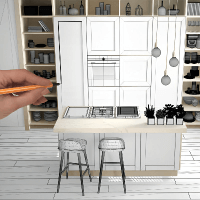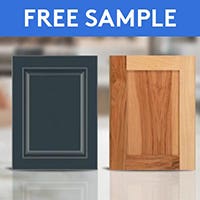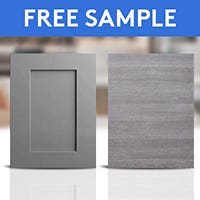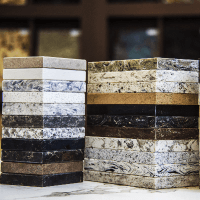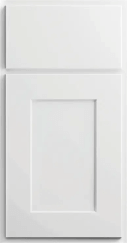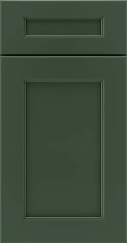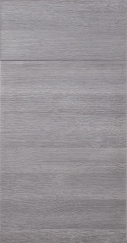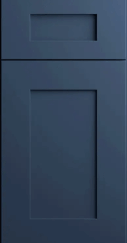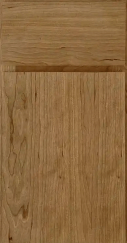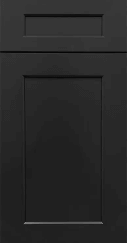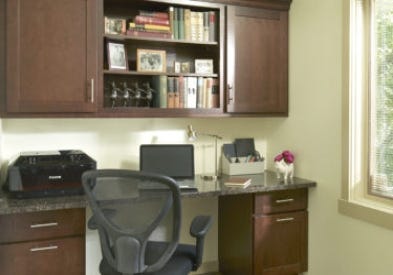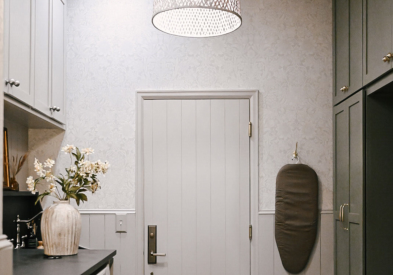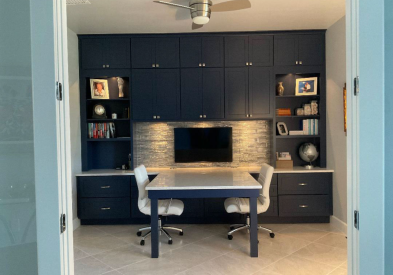4 Min. Read
The mark of a truly custom home is built-in cabinetry. Whether it’s an entertainment center, mudroom or other built-in, these elements allow anyone to personalize their home and gain much-needed storage for their family. Adding built-in cabinets to specific areas will also raise your home’s value, optimize function and elevate your overall design.
With so many options to choose from in every budget range, it’s easy to find a personalized built-in to elevate your home. To find the perfect option for you, we will explore types of built-ins, how to get the designer look and more below.


Types of Built-In Cabinets
- Entertainment
- Bookcase (study, office or bedroom)
- Built-in bench (bedroom, entryway or kitchen nook)
- Buffet cabinets
- Shelving
- Office cabinets
- Craft rooms
- Linen closets (hallways or bathrooms)
- Mudrooms






Principles of Built-In Cabinet Design
At the start of any new project, take inventory. It’s important to identify what’s working in your existing space and what’s not so you can create a well-rounded wish list. Wish lists commonly include your preferred design style, and specific cabinet accessories and materials you would like to use. Here are some designer principles to keep in mind while planning your project.
Principle #1: Keep it to Scale
After measurements are recorded, take into account how much space you have for built-ins. It’s easy to get excited about new projects and maximize every inch, but it’s possible to overdo it. For example, buffet cabinets are great storage and can be a beautiful focal point. However, when cabinets start extending past the natural sight lines of the dining room, it can look overdone and awkward. When designing your built-ins, keep the scale comparable to the room.
Principle #2: Don’t Overcrowd
Similarly, for built-in cabinetry by cased openings and doorways, always keep 3 – 6 inches of space between the cabinets and opening. This will provide a professional look and prevent crown molding or baseboard molding from creeping into the doorway.
Principle #3: Stay Conscious of Height
Short and tall ceilings have different rules when it comes to cabinet height. While designing built-ins with shorter ceilings- like bookcases, it’s possible to take cabinets to the ceiling. Avoid a heavy look by staying away from crown molding or use shorter wall cabinets for some visual relief.
Just the opposite is true for tall ceilings. In fact, crown molding can easily help define the space and create a grounded, balanced look. Prevent heaviness by designing your built-ins well below the highest point of the ceiling. Not only will this help show off your beautiful vault, but it will keep your space open and inviting.
How to Get a Designer Look
Do you remember the saying, ‘the devil is in the details’? In this case, the designer is in the details. Especially when it comes to built-in cabinetry. Designers have many different tools in their belt to create that must-have dreamy look, and now you get to learn about them. Here are some commonly used design details to elevate your design.


Decorative Moldings
Regardless of your design style, moldings provide a finished look. Use baseboard moldings to cover unsightly toe kicks or dress up basic cabinets. Crown molding is also great at drawing attention to focal points like built-ins around an entertainment center.
Decorative Panels
There is no shortage of end panel options to choose from. Shiplap style, reeded, beadboard, or furniture panels will all amplify your style while simultaneously upgrading the design. Cover standard recessed cabinet panels to create a professional custom look.
LED Lighting & Sconces
Whether it’s integrated into the shelves or LED strip lighting, consider adding this detail to your design. There’s no better way to show off your new cabinetry than by adding lighting. Easily create a feature for your room and show off décor, or subtle ambiance with soft lighting.
Décor, Décor, Décor
Even in minimalist homes, décor tends to make the design. One hard and fast rule is to avoid using the same finish, height, and pattern everywhere. Switch it up by using something smooth and something textured. Then add a tall and short element alternating these details in each cluster of décor. Variety is the key to keeping it interesting.
Common Materials for Built-In Cabinets


Most built-in projects are made from manufactured cabinets. Semi-custom and custom cabinets are more common options although RTA cabinets can also be used. Typically, using manufactured cabinets means you have access to a larger variety of door styles, finishes, panels, and cabinet accessories. Some homeowners prefer DIY, but for most, manufactured cabinets with furniture finishes are the way to go.
Start your own built-in cabinet project today. Explore cabinets now!
